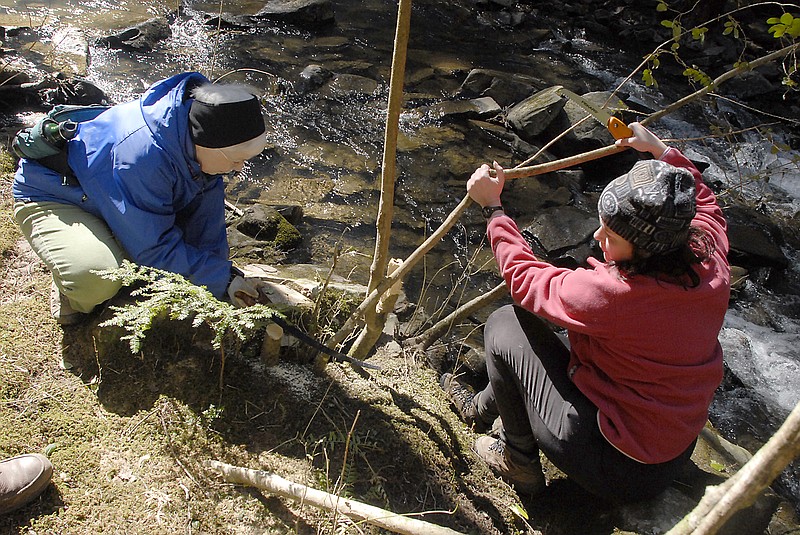Everyone knows about kudzu, the plant that ate the South, but as invasive species go, kudzu may soon be taking a back seat to some other unwelcome and foreign upstarts.
PDF: Kudzu in the Southeast PDF: Chinese privet in the Southeast PDF: Multiflora rose in the Southeast PDF: Japanese honeysuckle in the Southeast PDF: Cogongrass in the Southeast
Chinese privet, introduced to the United States more than a century ago as a hedge, has long since escaped to strangle vistas in local parks, forests and woodland edges.
Run-amok English ivy chokes oaks and poplars as surely as kudzu in some neighborhoods, while scratchy multiflora "pasture" rose from Asia -- once employed by settlers to make living cattle fences -- now creates impenetrably thorny thickets throughout the Cumberland Plateau and North Georgia regions.
And a major emerging worry in both Tennessee and Georgia is the much-feared, knife-edged and highly flammable cogongrass.
"It's a species that actually has the attention of a lot of different agencies and private landowners," said Terri Hogan, a Stones River National Battlefield ecologist and president of the Tennessee Exotic Pest Plant Council.
"There was one occurrence in Ringgold, but my understanding is it has been eradicated there," Ms. Hogan said. "We still have it in Jackson, (Tenn.) and South Georgia. And you see it often on the roadsides in Alabama."
Like most invasive and non-native plants, cogongrass provides poor forage. But it also cuts the mouths of animals that try to eat it. And when it burns -- which it does readily -- it creates profuse smoke that can create a driving hazard on roads as well as an air pollution problem.
Even departments of transportation are concerned about the grass, Ms. Hogan said.
"It's one species that everybody can get behind as a problem," she said.
Usual suspects
Less dramatic, but equally troublesome in other ways, escaped privet, honeysuckle, ivy and pasture rose cost untold manhours and recreation loss in public parks and backyards.
Carol Crabtree, park manager at Bradley County's Red Clay State Historic Park, said privet and mimosa thickets cover about five of the park's 270 acres.
"We cut the privet back when we can, but the (plant's) veins close up within about a minute, so you have to spray just as soon as you cut it. It's very time-consuming," Ms. Crabtree said.
Another problem, she said, is that the birds eat the berries produced by the privet, fly away and excrete the seeds in their droppings, so the pesky plant is constantly spreading.
In April, the Chickamauga and Chattanooga National Military Park will have volunteers helping to rid the historic Chickamauga Battlefield of privet and other invasives, as well as overgrown trees, in hopes of restoring the landscape to its Civil War-time scenery, according to park officials.
A similar cleanup in early March took Friends of South Cumberland State Park near Monteagle, Tenn., where they pulled and cut pasture rose, privet, honeysuckle and English ivy from the Fiery Gizzard Trail.
During the cleanup, when Sewanee Herbarium curator Mary Priestley pointed out an eight-inch diameter privet "tree" on the bank of Fiery Gizzard Creek, the eyes of retired educator and volunteer Mary Minton Davis widened.
"We'll need the man with the chainsaw for that," said Mrs. Davis, who was armed only with a hand-powered pruning saw.
David Gomez, park manager of New Echota State Historic Park near Calhoun, Ga., said Georgia hired a contractor in mid-February to spray herbicide on privet there. He said he soon will have to cut the dead shrubs and haul them out of the park.
"It's a constant battle, and I guess it always will be for everybody," he said.
Why it matters
Karan Rawlins, with the University of Georgia's Center for Invasive Species and Ecosystem Health at the Warnell School of Forestry and Natural Resources, said invasives are more than just landscaping problems -- especially in parks.
FINDING HELP* The Southeast Exotic Pest Plant Council's Web site, www.se-eppc.org/weeds.cfm, lists about 500 invasive plants.* The Tennessee Exotic Pest Plant Council Web site, www.tneppc.org, offers control methods for problem plants. Additionally, the Tennessee council is hosting the Southeast Council's annual meeting in Chattanooga on May 11-13. Information is online.* The Georgia Exotic Pest Plant Council's Web site is at www.gaeppc.org, and offers links to how-to help.Source: Web links
"When you're dealing with habitats, you can't just bulldoze. You still have to protect the ecosystems," she said.
The impact of such invasives are greater than most people realize, she said.
"We all like to see cardinals in the backyard, but they are impacted, too," she said. "They will eat the native food first, but when it's gone, they'll eat the non-native stuff. It's not as nutritionally fit for them."
In the plant community, when exotics take over a forest canopy, native wildflowers and lower-growing plants such as trilliums and dogwoods can't compete, she said.
The most unwelcome message, she said, is that the spread of invasives won't stop until we rethink our own backyards.
"But when every single one of us has privet hedges, nandina and honeysuckle in our yards, we're damaging our natural areas and wildlife," she said.
Continue reading by following these links to related stories:
Article: Braly: Kudzu may prove to be a valuable dietary supplement
